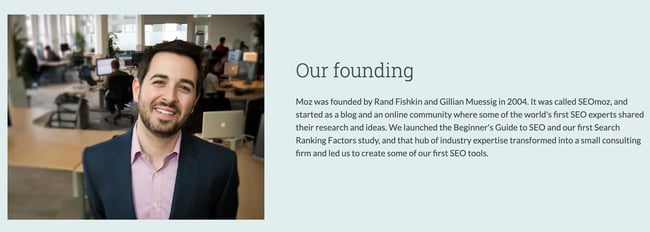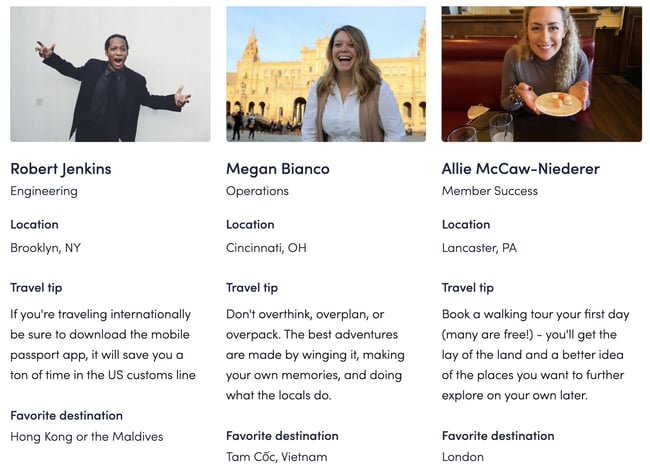What’s the one thing business owners and their employees, partners and even customers all have in common? Well, at the most basic level, they’re all human. So why is it sometimes so challenging for businesses to showcase this in their marketing efforts?

Perhaps some people don’t want to show any biases that might deter any potential leads. Perhaps some may want to present themselves as strictly professional. Others may not care about their tone at all, but would rather focus on finding the right keywords to implement throughout their platforms. Some may not even realize just how robotic their brand’s voice really is.
Either way, the truth of the matter is: humanizing your brand is no longer an option, it’s a necessity. People like making connections. They enjoy investing their time and money in people they know are on their side and can relate to. So in today’s highly competitive world, it’s definitely in every business’s best interest to find a way to connect to their customers and leads through humanization — no matter what industry you’re in.
Humanizing a Brand
Humanizing your brand means adopting a more relatable and personable communication style when interacting with customers instead of standard business jargon. Think of it as cultivating your brand’s personality and values through establishing meaningful connections with your audience.
Why is humanizing your brand important?
Brands are not humans but customers are. In order to sell, get more conversions, increase engagement and build brand loyalty, it’s importantto first build a relationship with customers. Similar to relationships with new friends, brands need to build a rapportand establish trust in order for the customer relationship to flourish.
Humanizing your brand and adding a level of personalization will help customers connect. All of your marketing efforts and website messaging should be crafted in a way that establishes a connection with your audience. Without it you could be perceivedas a cold, faceless entitythat spawns customer indifference instead of loyalty.
How to Humanize Your Brand
Here are some helpful tips for how to start making your brand’s voice more real:
1. Begin from the inside out.
In other words, start with creating good company culture. Your CEO(s) and upper management have the potential to spread that culture like wildfire throughout your company, allowing your team to be the true advocates you want them to be.
Then, post about it! If your company did a 5K, post a photo on Instagram of employees happily crossing the finish line. If your business’s office is festively decorated according to your brand’s colors and theme, post a video tour of it on your website. Or, if your team has recently completed a certification or won an award, talk about it on LinkedIn.
Showcasing your team members on your website and social media platforms goes a lot farther than just having the basics. And, when your followers/website viewers/etc. are able to see how great it is to work at your company, they’ll be more willing to trust your professional abilities.
2. Make your brand’s tone personal, approachable and engaging.
For many businesses, portraying themselves as industry leaders is essential to generating leads and gaining credibility. And while that is certainly a crucial piece of the puzzle, it doesn’t negate the need for a human element. The reality is, you can still have professional, educational or even highly technical content that still incorporates a fun, caring, or engaging tone.
Look at Dollar Shave Club (or any of the brands mentioned in Kim Speier’s blog “7 Boring Big Brands That Used Humor to Amp Up Their Marketing”).
The company's ads are known for being witty and silly. But most importantly, they're smart. They made a traditionally “boring” product and developed a brand voice that was approachable, fun and human. These three attributes build trust, credibility, and eventually brand loyalty. Looking to capitalize on the brand's following, the company was later acquired by Unilever.
3. Speak in your audience’s language.
You might have more than one group of people that make up your customer base. But none of those groups want to read or hear corporate jargon, sales talk or overly fluffed-up language.
If your company is B2B, communicate to your audience in an educational, informative way. If your company is B2C, strike an emotional chord. The better you are at learning your consumers’ language, the more approachable and “human” you’ll appear to them.
Just. Speak. Clearly. Business and industry-specific jargon is just another way of talking over people's heads, and although you think you sound super smart and important, you're really just coming off as inaccessible. Is that how you'd talk to someone in real life? No way. Unless you don't want any friends. Speak like a human being, and your brand will feel more relatable, too.
4. Write an 'About Us' page that's actually good.
The 'About Us' page is one of the most frequently flubbed-up pages on the internet. Which is a bummer, really, because what better way to humanize your brand than a page dedicated to telling people about who you are?
So, who do you want to be? A faceless corporation? Or do you want to tell people about what you do, who you are, and why you think it might be interesting to them? I went looking for an example to show off here. That's an extraordinaryexample of someone humanizing their company through their 'About Us' page, and thanks to Blog Tyrant, I found an example for you.
First, I recommend you check out SEOmoz. Their page includes several sections that explain what they do and why they're valuable, as well as a timeline that explains how their company came to be — written in a light-hearted yet professional way. Giving the backstory of how the company was founded gives readers insight into the founders' motivations, and also presents it in a way that shows the reader what value SEOmoz brings to the table for their customers.
5. Inject a sense of humor into your content.
It's easy for B2C companies to create hilarious content — and you certainly should! Everyone loves a laugh. Although this strategy is best for B2C companies, B2B brands can also get into the action. Take this Zendesk tweet describing a sales funnel for example.
The tweet uses down-to-earth language and emojis to make the brand more relatable to its audience while presenting an ad that explains how its services can help improve your sales funnel.
You can get your point across really well with clear, concise, straightforward copy. That's fine. But you can get your point across and humanize your brand — even delight readers — if you can infuse a sense of humor into your content once in a while. Frankly, nobody expects it from B2B brands. And if you're one of the few brands doing it, it makes you look just awesome. Go ahead. Try to make someone crack a smile. What's more human than unbridled laughter?
6. Focus more on offering resources than making a sale.
If you’re not already familiar with inbound marketing, you know that the statement above is essentially the gist of it. Give your viewers something of value to them (without the sales pitch) and they will seek you out for more. This whole step is about creating relationships through trust that’s built on you providing helpful, credible resources. This can be something as simple as a how-to blog post on an industry topic or industry case study.
Inbound marketing also ties in with speaking your audience’s language. While offering these resources, be sure to do so in a way that most effectively speaks to your audience. You’ll also want to be sure to offer the right kind of materials they will actually want to consume.
No matter what your inbound marketing efforts consist of, try to keep them focused on how it will benefit the end-user, not your company.
7. Keep an active blog on your website.
This is an easy — and most importantly — freeway to show a human side to your audience. Not only does keeping an active blog help with boosting your SEO, staying up to date with topics in your industry and becoming more purpose-driven in your efforts, but it also helps with showing your human side.
It allows readers to see that you’re current, active and educated, giving you more credibility. Plus, as we mentioned in the previous tip, it also helps with your inbound marketing by providing readers with information or educated opinions on topics they’re seeking out. It’s a win-win situation for everyone.
8. Showcase your community manager.
If your business has a community manager or similar role, let them take the spotlight for your company by showcasing them on all your online platforms.
Display their Twitter handle or email address so readers can easily access them with questions or concerns. Giving people a face to your community manager will make them feel more comfortable with your brand as a whole and will help build a strong relationship between you both.
9. Engage with fans, followers, and commenters.
But make sure they aren't all just about your company or industry — although those are important, too. When you venture outside of your usual topics once in a while, it makes people feel comfortable being themselves ... because you're being yourself, too! You can also add more structure to these conversations if you like and periodically host Twitter chats — conversations about a particular topic at a specific date and time, held together by a pre-designated hashtag.
Additionally you can keep it light like media company Mitú and engage over something fun and seasonal like horcata ice cream. Whatever the topic — if your followers are commenting, reply back.
10. Publish photos of your team being themselves.
Let your fans and followers get to know your employees a bit better by posting photos of them doing things "out in the wild" or at company events. Displaying these on your careers page, social media, or “About Us” page are all good spots to showcase what working for your company is like for employees.
The photo above is from Scott’s Cheap Flights. The company adds a human touch by not only giving the spotlight to some of their employees, but also showcasing how knowledgeable they are by having each provide a travel tip and their favorite destination. It’s much more inviting than just using a standard photo and listing their position. With just one to two sentences, customers are able to get to know employees and view them as credible resources.
11. Encourage employees to be social on behalf of your company.
When employees post social media updates about or on behalf of their company, it does a few things:
- It lets people know that person gives a hoot about the company they work for.
- It lets people get to know the names, faces, and personalities behind a company.
- It gives the company's content much more reach.
While some companies, due to the nature of their industry, may need to keep a tighter lid on their social media networks, most businesses could really benefit from encouraging employees to use their social media accounts to share company content. And yes, they should even be able to do that during work hours! The times, they are a-changin'.
12. Apologize and say “Thank You” when necessary.
As every human knows, we all have our flaws and we all make mistakes. But when it comes to our businesses, we often try to protect our reputations at all costs, even if it’s our businesses that are at fault. And we mustn’t forget that our businesses are, in fact, made up of humans.
So if you’ve dropped the ball somehow, come to your audience with a sincere apology anda potential solution to the problem. People will appreciate you addressing the situation head-on, as opposed to them coming to you with their complaints.
More than that, though, you should be thanking your fans/followers/customers/advocates/etc. often. Something as simple as an Instagram post celebrating reaching 5,000 followers and thanking them specifically for helping you reach that milestone goes a long way.
Or, send out an email to current and past customers (perhaps on Thanksgiving) expressing your gratitude for their business. This is another way of making your audience see you as humans who care about them as humans, not simply a money-hungry company that’s uninterested in building relationships.
13. Be available.
This isn’t just a tip for upper management, nor is it just a tip for your customer service department. It’s for every member of your team and every part of your brand’s online persona.
Humanizing a brand can’t happen without actual humans being available to do it. For example, if someone at your business posts regularly to your social media platforms, he or she should also be available to respond to comments, questions, reviews, etc. Too often businesses simply schedule out their social posts for the month, ignoring the importance of frequent engagement.
This is a great opportunity to show that your business has a human side to it and is willing to help these followers get information, share ideas, and feel good about promoting your brand.
14. Sign your emails with your name. Like, your name.
Not your company name. A company can't send an email. A person at your company, however, can. For instance, what does your signature look like in your email marketing? Consider including a real person's name in your email signature, along with their role at your company, and maybe even a small headshot to make the message more personal.
You could also experiment with a more personal "From" field, including the email sender's real name alongside your company's name. Your results may vary, so we recommend conducting your own test, but when we A/B tested the inclusion of an employee's name alongside our company name, the results were fantastic!

15. Take off your marketer hat once in a while.
Ultimately, you're doing all this to get more traffic, leads, and customers. We know that. But it can be helpful to approach your efforts with a little less of a methodical marketer mindset, and more of a ... human one.
It's okay to throw in something you think your audience would just plain enjoy sometimes — no link to your blog, lead-capture form, or transaction on the other end. The more you get to know your buyer personas as you interact with them every day, the more naturally you'll be able to do this; the content will practically roll off your tongue! Once you've established this natural rapport with your community, your relationship will be more akin to two friends hanging out — and that makes for customers with higher lifetime value (aaaand the marketer hat is back on).
Give Your Brand a Human Touch
All in all, humanizing your brand has a multitude of benefits, including gaining credibility and getting your voice heard. Use these eight simple tips to get started today!
Editor’s Note: This article was originally published in April 2015 and has been updated for comprehensiveness.















![Want to Be a Better Marketer? You Should Be Keeping Up With The Kardashians [Video]](https://blog.hubspot.com/hubfs/kardashians-450-million.png)
